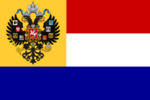Halicz-Słupica
This article is incomplete because it is pending further input from participants, or it is a work-in-progress by one author. Please comment on this article's talk page to share your input, comments and questions. Note: To contribute to this article, you may need to seek help from the author(s) of this page. |
Kingdom of Halicz-Słupica Królestwo Halicko-Słupickie | |
|---|---|
|
Flag | |
| Capital | Halicz |
| Largest city | Halicz |
| Official languages and national languages |
|
| Regional and other languages |
|
| Ethnic groups (2036) |
|
| Demonym(s) | Haliczan |
| Government | Constitutional monarchy |
• King | Stefan |
• Prime Minister | Anna Spierkowska |
| Legislature | Parliament |
| Council of Delegates | |
| Legislative | |
| Independence from Rumelia | |
• Declared | 1655 |
• Union of Halicz and Słupica | 1756 |
| Area | |
• Total | 747,401 km2 (288,573 sq mi) |
| Population | |
• 2036 census | 104,001,036 |
• Density | 139.15/km2 (360.4/sq mi) |
| Currency | Haliczan złoty (HSZ) |
| Date format | dd/mm/yyyy |
| Driving side | right |
| Calling code | +64 |
| Internet TLD | .hs |
The Kingdom of Halicz-Słupica, commonly known as Halicz-Słupica, is a sovereign country in western North Osea. It is bordered by the Ceres Ocean in the west and Souloun in the north. The total area of Halicz-Słupica is 747 401 km2 and its population equals roughly 104 million (as of 2036).
Halicz-Słupica is a parliamentary democracy and a constitutional monarchy. Its capital is Halicz, which is also the largest city in the country with a population of 8.468 million. The country is comprised of 11 provinces, one of which is the Capital City of Halicz.
The symbolic beginning of Haliczan history are the Baptism of Halicz in 975 and the subsequent incorporation of the borough of Halicz into the Duchy of Owrucz. Nearly 100 years later, count Bolesław II conquered Owrucz and proclaimed the Kingdom of Halicz. However, it was annexed by the neighbouring country of Rumelia in 1241 following an unsuccessful war. This event marked the beginning of an over 400 years long period of foreign rule. During that time, the Free City of Słupica was established on the West Sea coast near Halicz and just outside of Rumelian borders.
In the 1640s, Rumelia became overcome with unrest and responded to this threat with repressions. This led to a Haliczan uprising breaking out in 1655 and starting the 4 year long War of Haliczan Independence, which ended with a decisive Haliczan victory. The leader of the insurgents, Karol Halicki, was elected as the first Duke of Halicz under the name of Karol III. The country entered a period of intense development, culminating in the reign of Felicjan I (1740-1786), often described as the golden age of Halicz.
Following an ultimatum by the Duchy of Halicz, the Free City of Słupica was forced to enter a union with it in 1756, forming the Grand Duchy of Halicz-Słupica. During the following decades, the autonomy of Słupica was significantly reduced, resulting in its formal incorporation in 1772. In 2026, Grand Duke Stefan proclaimed himself the King of Halicz-Słupica, thus changing the country's name to the Kingdom of Halicz-Słupica.
Etymology
The name of Halicz-Słupica comes from a union established in 1756 between two states: the Duchy of Halicz and the Free City of Słupica. Both of these states were named after their respective capitals.
History
Geography
The total area of Halicz-Słupica is 747 401 square kilometres. The country is situated on the eastern coast of the West Sea. It mostly consists of plains with the elevation rising eastwards, though it also contains highlands on the eastern border, a desert in the northwest and the Białe Mountains mountain range in the centre which separates southwest Halicz-Słupica from the rest of the country. The highest peak is Mount Szramy at 2780 metres above the sea level.
Government and politics
Halicz-Słupica is an unitary constitutional monarchy and a representative democracy.
The monarch, currently King Stefan I, is the head of state, but their role is mostly ceremonial. Nonetheless, the monarch retains the right of veto, as well as limited prerogatives. Most of the executive power is held by the Council of Ministers (Rada Ministrów) which answers to the bicameral parliament and is led by the Prime Minister.
